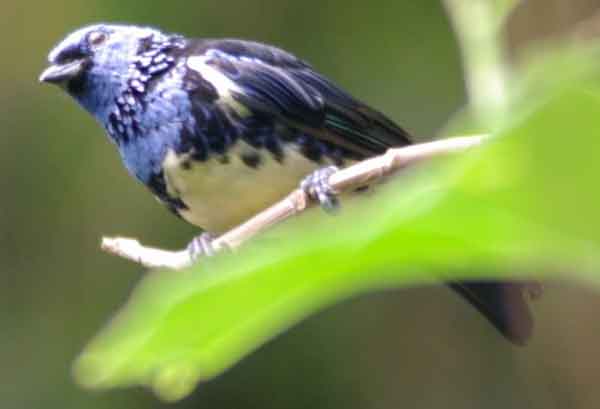
Tangara mexicana (*)
Superregnum: Eukaryota
Cladus: Unikonta
Cladus: Opisthokonta
Cladus: Holozoa
Regnum: Animalia
Subregnum: Eumetazoa
Cladus: Bilateria
Cladus: Nephrozoa
Superphylum: Deuterostomia
Phylum: Chordata
Subphylum: Vertebrata
Infraphylum: Gnathostomata
Megaclassis: Osteichthyes
Cladus: Sarcopterygii
Cladus: Rhipidistia
Cladus: Tetrapodomorpha
Cladus: Eotetrapodiformes
Cladus: Elpistostegalia
Superclassis: Tetrapoda
Cladus: Reptiliomorpha
Cladus: Amniota
Classis: Reptilia
Cladus: Eureptilia
Cladus: Romeriida
Subclassis: Diapsida
Cladus: Sauria
Infraclassis: Archosauromorpha
Cladus: Crurotarsi
Divisio: Archosauria
Cladus: Avemetatarsalia
Cladus: Ornithodira
Subtaxon: Dinosauromorpha
Cladus: Dinosauriformes
Cladus: Dracohors
Cladus: Dinosauria
Ordo: Saurischia
Cladus: Eusaurischia
Cladus: Theropoda
Cladus: Neotheropoda
Cladus: Averostra
Cladus: Tetanurae
Cladus: Avetheropoda
Cladus: Coelurosauria
Cladus: Tyrannoraptora
Cladus: Maniraptoromorpha
Cladus: Maniraptoriformes
Cladus: Maniraptora
Cladus: Pennaraptora
Cladus: Paraves
Cladus: Eumaniraptora
Cladus: Avialae
Infraclassis: Aves
Cladus: Euavialae
Cladus: Avebrevicauda
Cladus: Pygostylia
Cladus: Ornithothoraces
Cladus: Ornithuromorpha
Cladus: Carinatae
Parvclassis: Neornithes
Cohors: Neognathae
Cladus: Neoaves
Cladus: Telluraves
Cladus: Australaves
Ordo: Passeriformes
Subordo: Passeri
Infraordo: Passerida
Superfamilia: Passeroidea
Familia: Thraupidae
Genus: Tangara
Species: Tangara mexicana
Subspecies:
Group: T. m. mexicana – T. m. boliviana – T. m. media – T. m. vieilloti
Dubious taxon or synonym: T. m. lateralis
Group: T. m. brasiliensis
Name
Tangara mexicana (Linnaeus, 1766)
Type locality: Cayenne, French Guiana.
Synonyms
Tanagra mexicana (protonym)
References
Linnaeus, C. 1766. Systema naturae per regna tria naturae, secundum classes, ordines, genera, species, cum characteribus, differentiis, synonymis, locis. Editio duodecima, reformata. Tomus 1 (Regnum Animale), Pars 1: 1–532. Holmiæ [Stockholm]. Impensis Direct Laurentii Salvii. Original description p. 315 BHL Reference page.
Vernacular names
English: Turquoise Tanager
español: Tangara turquesa
português: Saíra-de-
The turquoise tanager (Tangara mexicana) is a medium-sized passerine bird in the tanager family Thraupidae. It is a resident bird from Trinidad, much of Brazil (despite its scientific name, it is not found in Mexico), Colombia and Venezuela south to Bolivia. It is restricted to areas with humid forest, with its primary distribution being the Amazon, while a disjunct population occurs in the Atlantic Forest of eastern Brazil. The latter population is sometimes considered a separate species, the white-bellied tanager (Tangara brasiliensis) .
It occurs in forest, woodland and cultivation. The bulky cup nest is built in a tree or shrub, and the female incubates three brown-blotched grey-green eggs.
These are social birds usually found in groups. They eat a wide variety of fruit and also take insects, often gleaned from twigs.
Taxonomy
The turquoise tanager was formally described in 1766 by the Swedish naturalist Carl Linnaeus in the 12th edition of his Systema Naturae under the binomial name Tanagra mexicana.[2] His description was principally based on Mathurin Jacques Brisson's Le tangara blue de Cayenne that he had described and illustrated in 1760.[3] The type locality is Cayenne in French Guiana.[4] The turquoise tanager is now placed in the genus Tangara that was introduced by Brisson.[5][6]
Five subspecies are recognised:[6]
T. m. vieilloti (Sclater, PL, 1857) – Trinidad
T. m. media (Berlepsch & Hartert, 1902) – east Colombia and Venezuela
T. m. mexicana (Linnaeus, 1766) – the Guianas to central Brazil
T. m. boliviana (Bonaparte, 1851) – southeast Colombia to east Ecuador, east Peru, west Brazil and north Bolivia
T. m. brasiliensis (Linnaeus, 1766) – southeast Brazil
Description
Adult turquoise tanagers are 14 cm long and weigh 20 g. They are long-tailed and with a dark stout pointed bill. The adult is mainly dark blue and black, with turquoise edging to the primaries. Most races have yellow lower underparts, but this is paler, more cream in the nominate subspecies found in north-eastern South America. The Trinidadian race, T. m. vieiloti, has a darker blue head and breast and more vividly yellow underparts than the mainland taxa, but this difference is only obvious compared to the nominate and brasiliensis. The taxon brasiliensis differs conspicuously from all other races, it being larger, having an overall duller blue plumage, blue edging to the primaries and a white belly. Their song is a fast squeaky chatter tic-tic-tic-tic-tic.
Gallery
T. m. brasiliensis with pale blue plumage, blue primary edging and white belly is sometimes considered a separate species
T. m. vieiloti from Trinidad is the darkest subspecies
References
BirdLife International (2017) [amended version of 2016 assessment]. "Tangara mexicana". IUCN Red List of Threatened Species. 2017: e.T103849376A119556880. Retrieved 9 April 2021.
Linnaeus, Carl (1766). Systema naturae : per regna tria natura, secundum classes, ordines, genera, species, cum characteribus, differentiis, synonymis, locis (in Latin). Vol. 1, Part 1 (12th ed.). Holmiae (Stockholm): Laurentii Salvii. p. 315.
Brisson, Mathurin Jacques (1760). Ornithologie, ou, Méthode Contenant la Division des Oiseaux en Ordres, Sections, Genres, Especes & leurs Variétés (in French and Latin). Vol. 3. Paris: Jean-Baptiste Bauche. p. 6, Plate 1 fig. 3.
Paynter, Raymond A. Jr, ed. (1970). Check-List of Birds of the World. Vol. 13. Cambridge, Massachusetts: Museum of Comparative Zoology. p. 361.
Brisson, Mathurin Jacques (1760). Ornithologie, ou, Méthode Contenant la Division des Oiseaux en Ordres, Sections, Genres, Especes & leurs Variétés (in French and Latin). Paris: Jean-Baptiste Bauche. Vol. 1 p. 36 and Vol. 3 p. 3.
Gill, Frank; Donsker, David; Rasmussen, Pamela, eds. (July 2020). "Tanagers and allies". IOC World Bird List Version 10.2. International Ornithologists' Union. Retrieved 17 October 2020.
Retrieved from "http://en.wikipedia.org/"
All text is available under the terms of the GNU Free Documentation License

